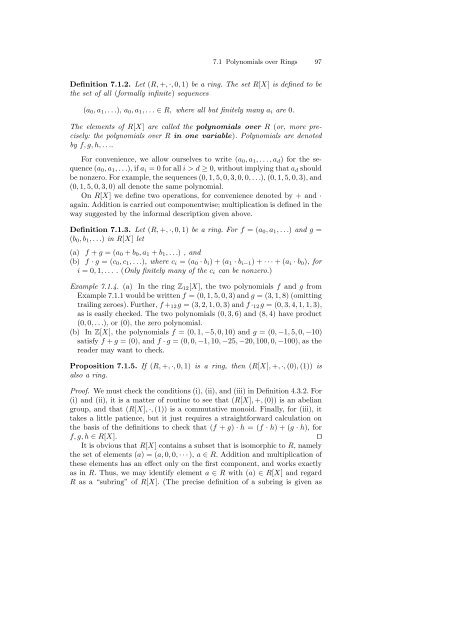Dietzfelbinger M. Primality testing in polynomial time ... - tiera.ru
Dietzfelbinger M. Primality testing in polynomial time ... - tiera.ru
Dietzfelbinger M. Primality testing in polynomial time ... - tiera.ru
You also want an ePaper? Increase the reach of your titles
YUMPU automatically turns print PDFs into web optimized ePapers that Google loves.
7.1 Polynomials over R<strong>in</strong>gs 97<br />
Def<strong>in</strong>ition 7.1.2. Let (R, +, ·, 0, 1) be a r<strong>in</strong>g. The set R[X] is def<strong>in</strong>ed to be<br />
the set of all (formally <strong>in</strong>f<strong>in</strong>ite) sequences<br />
(a0,a1,...), a0,a1,...∈ R, where all but f<strong>in</strong>itely many ai are 0.<br />
The elements of R[X] are called the <strong>polynomial</strong>s over R (or, more precisely:<br />
the <strong>polynomial</strong>s over R <strong>in</strong> one variable). Polynomials are denoted<br />
by f,g,h,....<br />
For convenience, we allow ourselves to write (a0,a1,...,ad) forthesequence<br />
(a0,a1,...), if ai =0foralli>d≥ 0, without imply<strong>in</strong>g that ad should<br />
be nonzero. For example, the sequences (0, 1, 5, 0, 3, 0, 0,...), (0, 1, 5, 0, 3), and<br />
(0, 1, 5, 0, 3, 0) all denote the same <strong>polynomial</strong>.<br />
On R[X] we def<strong>in</strong>e two operations, for convenience denoted by + and ·<br />
aga<strong>in</strong>. Addition is carried out componentwise; multiplication is def<strong>in</strong>ed <strong>in</strong> the<br />
way suggested by the <strong>in</strong>formal description given above.<br />
Def<strong>in</strong>ition 7.1.3. Let (R, +, ·, 0, 1) be a r<strong>in</strong>g. For f =(a0,a1,...) and g =<br />
(b0,b1,...) <strong>in</strong> R[X] let<br />
(a) f + g =(a0 + b0,a1 + b1,...) ,and<br />
(b) f · g =(c0,c1,...), whereci =(a0 · bi)+(a1 · bi−1)+···+(ai · b0), for<br />
i =0, 1,... . (Only f<strong>in</strong>itely many of the ci can be nonzero.)<br />
Example 7.1.4. (a) In the r<strong>in</strong>g Z12[X], the two <strong>polynomial</strong>s f and g from<br />
Example 7.1.1 would be written f =(0, 1, 5, 0, 3) and g =(3, 1, 8) (omitt<strong>in</strong>g<br />
trail<strong>in</strong>g zeroes). Further, f +12g =(3, 2, 1, 0, 3) and f ·12 g =(0, 3, 4, 1, 1, 3),<br />
as is easily checked. The two <strong>polynomial</strong>s (0, 3, 6) and (8, 4) have product<br />
(0, 0,...), or (0), the zero <strong>polynomial</strong>.<br />
(b) In Z[X], the <strong>polynomial</strong>s f =(0, 1, −5, 0, 10) and g =(0, −1, 5, 0, −10)<br />
satisfy f + g =(0),andf · g =(0, 0, −1, 10, −25, −20, 100, 0, −100), as the<br />
reader may want to check.<br />
Proposition 7.1.5. If (R, +, ·, 0, 1) is a r<strong>in</strong>g, then (R[X], +, ·, (0), (1)) is<br />
also a r<strong>in</strong>g.<br />
Proof. We must check the conditions (i), (ii), and (iii) <strong>in</strong> Def<strong>in</strong>ition 4.3.2. For<br />
(i) and (ii), it is a matter of rout<strong>in</strong>e to see that (R[X], +, (0)) is an abelian<br />
group, and that (R[X], ·, (1)) is a commutative monoid. F<strong>in</strong>ally, for (iii), it<br />
takes a little patience, but it just requires a straightforward calculation on<br />
the basis of the def<strong>in</strong>itions to check that (f + g) · h =(f · h) +(g · h), for<br />
f,g,h ∈ R[X]. ⊓⊔<br />
It is obvious that R[X] conta<strong>in</strong>s a subset that is isomorphic to R, namely<br />
the set of elements (a) =(a, 0, 0, ···), a ∈ R. Addition and multiplication of<br />
these elements has an effect only on the first component, and works exactly<br />
as <strong>in</strong> R. Thus, we may identify element a ∈ R with (a) ∈ R[X] and regard<br />
R as a “subr<strong>in</strong>g” of R[X]. (The precise def<strong>in</strong>ition of a subr<strong>in</strong>g is given as












